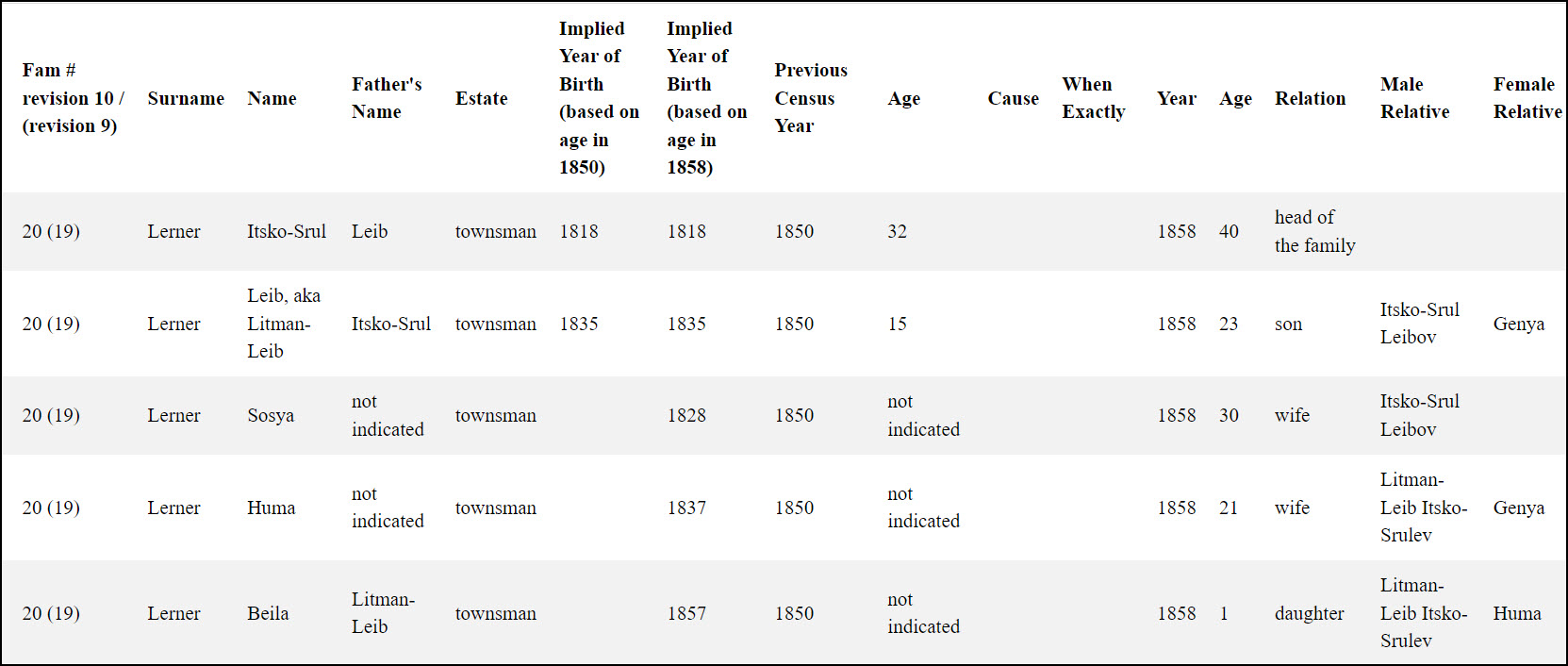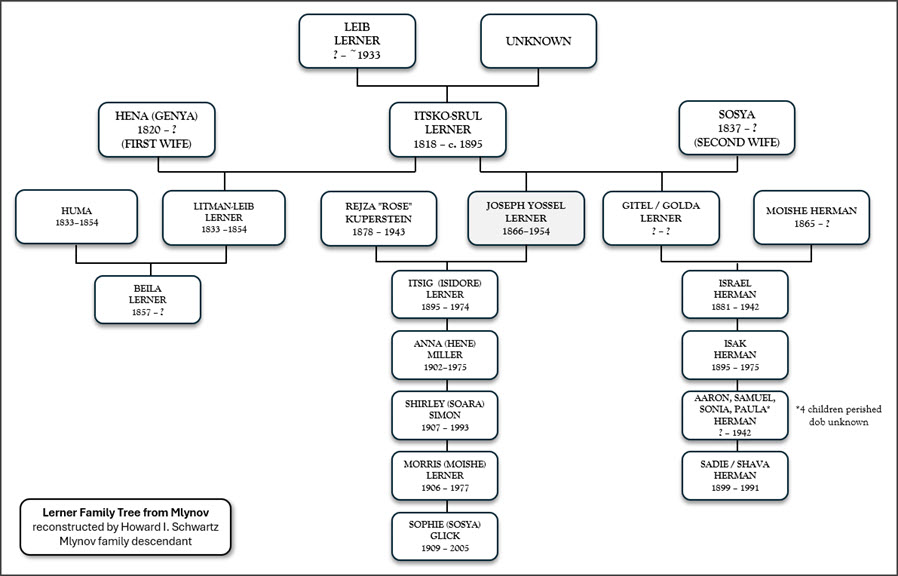-
Home
Home About Network
- History
Nostalgia and Memory The Polish Period I The Russian Period I WWI Interwar Poland 1944 Memorial Commemoration- People
Famous Descendants Families from Mlynov Ancestors By Birthdates- Memories
. The Lerner Family from Mlynov

***
(Back to the beginning ...)
The Lerner Family in Mlynov (continued)
According to US records, Yossel Abram Lerner was born in Mlynov in 1866. His tombstone in Baltimore shows that his father’s name in Hebrew was “Yitzchak Yisrael.” It seems highly probable that Yossel was born into the Lerner family listed in the 1850 and 1858 revision lists for Mlynov.
The head of that Lerner household in 1858 was a man named Itsko-Srul, a Yiddish variation on the Hebrew name “Yitzchak Yisrael” which appears on the tombstone of Joseph (Yossel) Lerner. In 1858, seven years before Yossel was born, this Lerner family had five members and was in a list of households of other “craftsmen” in town. This trade background of the family plausibly explains where Yossel got his own training as a mason, the occupation he listed on his passenger manifest to Baltimore in 1913.
 The Lerner family in the 1858 revision in Mlynov.
The Lerner family in the 1858 revision in Mlynov.According to the 1858 record, Itsko-Srul was 40 years old with an implied birth year of 1818. His deceased father's name was Leib. In the same census, he was married to a woman named Sosya who was 30 years old. Sosya appears to be Yosel’s second wife, since his son Leib (also called “Litman-Leib” in this record) was 23 years old and obviously too old to be the son of Sosya, who was only seven years older. The same 1858 record indicates Litman-Leib (Itsko-Srul’s son) was already married to a woman named Huma who was 21 years old. The couple had a one-year-old daughter, named Beila, suggesting that they had perhaps married in about 1857.
It seems very likely that Yossel (Joseph) Lerner was the son of Itsko-Srul and his second wife, Sosya. Itsko-Srul would have been 46 years old when Yossel was born in 1866. Yossel’s mother, Sosya, would have been 38 years old at his birth. It seems likely that Yossel’s eldest son, Itsig Israel (i.e., Isadore Lerner), was named for his grandfather, Itsko-Srul, and that Yossel’s daughter, Sophie (“Sosya” in Hebrew) was named for her grandmother. It is not known what happened to Yossel’s half-brother, Litman-Leib, or Litman-Lieb’s daughter, Beila, who are listed in this 1858 revision.
 The Lerner family in the 1850 revision in Mlynov.
The Lerner family in the 1850 revision in Mlynov.The earlier 1850 revision provides additional insights into the Lerner family. In 1850, Itsko-Srul was 32 years old. This record gives the name of his deceased father, Leib. Itsko-Srul is also listed with his first wife, Hena (also spelled Genya), who was 30 years old. Their son, Leib, was obviously a namesake of his grandfather. In 1850, he was only 15 years old, still single, and was not yet called Litman-Leib. Leib Jr.’s age of 15 suggests that his grandfather, Leib, probably died not long before 1835 when the younger Leib was born. The 1850 revision also indicates that Itsko-Srul was present in Mlynov by at least 1834 when an earlier revision was taken, though that record has not been recovered.
***
In Mlynov 1865–1913
While we know that Yossel (Joseph) Lerner was born in 1866 from US records, we know little else about the Lerners during the period Yossel was growing up. Yossel was still a teenager in 1882 when a well-known Rebbe (Aharon II of Karlin) died near Mlynov, putting the small shtetl on the map and making it a pilgrimage site for the Stolin-Karliner stream of Hasidim. Like other Mlynover boys his age, Yossel probably enjoyed swimming in the Ikva River in summer, climbing the mythic hill known as “Mount Sinai” across the river, and telling tales about the “Graf,” the Count who owned the large estate across the river and all the property in town. Perhaps he helped his father Itsko-Srul with carpentry and built some of the houses and fences that appear in later photos of the town.
By about 1894, Yossel Lerner married a Mlynov–born woman known in some of her US records as “Rose Lerner.” It appears that Yossel knew Rose growing up in Mlynov. She was part of the family in Mlynov called “Kuperstein and Kipperstein.” She had at least three siblings, two of whom came to the US. (See the Cooperstein/Kuperstein Story).
Yossel and Rose’s eldest son, Itsig Yisrael, was born in 1895. Yossel was 29 years old, and Rose was 25 when they became parents. The couple had four additional children after Itsig. Their dates of birth are a bit ambiguous since US records are not entirely consistent. They were Anna (Hene) 1902, Morris (Moishe) 1906, Sarah/Shirley (Sura) 1905/06, and Sophie (Sosya) 1910. Joseph left for Baltimore in 1913 when Sophie was three years old.
***
Yossel’s sister, Gitel (Lerner) Herman
It appears that Yossel Lerner grew up with at least one other sister named Chaya Golda. As noted earlier, evidence of their relationship comes from Yossel’s manifest to the US which lists his destination as the address of a “nephew” named Israel Herman. Quite a bit is known about Israel Herman. He was the son of a couple named Moishe Herman (surname also spelled Erbman and Herbsman) and a woman called variously in records as Chaya Golda and Goldie.
Support for the hypothesis that Chaya Golda was likely Yossel Lerner's sister comes from several sources: there is a social security record in Ancestry that lists her birth name as “Goldie Lerner” and her husband as Moishe “Herbsman.” In addition, the tombstone of Golda’s son, Israel Herman, indicates his Hebrew name was “Yitzhak Yisrael,” the same name that Yossel Lerner, gave to his son Itsig Lerner. Apparently, both Yossel and his sister Chaya Golda named sons after their father, Itsko-Srul, the head of household listed in the 1858 Mlynov revision. Finally, DNA matches between great-grandchildren of Yossel Lerner and Chaya Golda (Lerner) Herman support this hypothesis.
Chaya Golda Lerner married a Dubno-born man named Moishe Herman (Erbman, Herbsman) by 1891 when their son Israel Herman was born. Israel was followed by the birth of Isaac in 1895 and Sadie (married name Korn) in 1899. Four other children were born who perished in the Shoah and the dates of their births are not currently known. Golda and Moishe’s son, Israel Herman, married Mollie Gruber (from the Demb family line) and they had 7 children, two of whom were born in the US. As noted earlier, Israel Herman came to the US in 1911 and was followed by his wife and children in 1912. Their story is told in detail as part of the Herman Family story.
***
The 1920 Lerner Migration from Mlynov
By the end of 1919, Itsig began to make plans to return to his hometown. Apparently, Itsig brought his US army uniform with him. The uniform played a memorable role in the stories recounted later by a young man who joined Itsig and the immigrating group of families on their way to Baltimore. As Itsig made plans to return home, he coordinated with three other Mlynov-born husbands whose wives and children were also stranded during the War. They were Aaron Demb, Isaac Marder, and Nathan Gruber.A passenger manifest from June 1920 shows a large party of immigrants from Mlynov leaving Southampton, England for Baltimore. We know from oral traditions in the Fishman family that they traveled by train to Warsaw first where they got their papers. They probably caught passage to Southampton on a ship from Bremen or Rotterdam. They departed Southampton on June 9th and arrived in New York on June 19th.
The party included three Mlynov wives, nine of their children, plus one teenage boy from the Fishman family, a young man who appears on the manifest as “Boks Fishman” and whose memories provide additional insights into these families’ migration experience.
In the traveling party was Itsig’s mother “Radie,” [i.e., Rose] and Itsig’s four siblings, Hene (Anna), age 18, Soara (Sarah, Shirley), age 13, Mojsche (Moshe/Morris), age 10, and Spre (Sosya, Sophie), age 11. The group also included Isaac Marder’s wife, Clara, and her three children, and Aaron Demb’s wife, Bejla, and her two sons. Itsig also coordinated with Nathan’s wife but they followed a month later.
The June manifest lists “Melnow” as the last residence of both the Lerner and the Marder families. Radie (Rose) Lerner lists her closest friend there as Mrs. Lamden, a sister probably of the famous Itzhak Lamden from Mlynov. On the second page of their manifest, the wives Rose Lerner and Clara Marder list their destination as their two husbands at “1516” Presbury (also spelled Presburg) Street in Baltimore. Isak Marder was living there and Joseph Lerner was renting a room from him.
Itsig was not listed on the manifest with his mother and siblings. However, since he was already a naturalized citizen, he is listed instead on another page of the manifest with US citizens. He appears next to his new wife, “Gitel” (Czainik), whom he married on his trip back to Mlynov. Because US laws before 1922 conferred a husband’s citizenship status on his wife, Gitel is also listed as a citizen on the manifest.
A Lerner family oral tradition recalls that Itsig was set up with Gitel on the trip. We can guess that Gitel quickly fell for this Jewish boy who served in the US army and came back to Poland. According to a short memoire she wrote, Gitel was apparently born in a place called Michalkovitz but grew up in Oleksandriia, Russia (today in Ukraine). She writes in her memoire:
Per custom at that time the first grandchild was born in the home of the maternal grandparents so I was born in the village of Michalkovitz but raised in the little shtetl of Aleksandria [now Oleksandriia, Ukraine] a railroad town where for 16 kopeks you could ride four times daily to the large city of Rovno an industrial commercial and town of many institutions of learning. Aleksandria had only one small grade school so most of our primary grade learning was acquired from private tutors in Russian, German, or French and the Hebrew also from private teachers as our father insisted that both his sons and daughter learn as much as he could afford to pay for …
Oleksandriia is just 16 km (10 m) north of Rovno which is 55 km (34 m) northwest of Mlyniv. Itsig and the migrating families went to Rovno from Mlynov before heading to Warsaw where they got their visas. It seems very possible that Itsig and Gitel met or were set up in Rovno at the time.
Although there are no records of Itsig Lerner’s presence in Mlynov, the story of his return became mythic in the oral history of the young teenager, Benjamin Fishman, who joined the traveling immigrants. According to Ben’s account, there was an extra ticket or space available somehow with the traveling party and his friend poked Ben and suggested he join the party. Benjamin agreed without asking his parents’ permission. Ben recalled that Itsig brought his army uniform with him and that the uniform played a key role in their immigration experience. Itsig insisted the group of travelers ride first class on the train to Warsaw where they would secure their visas to leave. None of the travelers had traveled first class before and felt quite uncomfortable doing so in the newly created Poland. As an American, Itsig insisted, and he put on his US army uniform so that no one would give them any trouble.
***
Settling into Baltimore
In the 1920s, the Lerner family settled into life in Baltimore and began to expand. By the end of the decade, two more of their children (Morris and Sarah) married and Joseph and Rose had a total of 5 grandchildren. In the 1920s, Joseph remained working in the garment industry, and he and Rose and the four younger children made up one household, at least until Morris and Sarah got married. Joseph and Rose and the four children lived initially in East Baltimore at 9 Wolfe Street until the late 1920s.
You can download the full Lerner Family Story to read more or return to the beginning of the Lerner story.
***
Compiled by Howard I. Schwartz
Updated: July 2024
Copyright © 2021 Howard I. Schwartz, PhD
Webpage Design by Howard I. Schwartz
Want to search for more information: JewishGen Home Page
Want to look at other Town pages: KehilaLinks Home Page
This page is hosted at no cost to the public by JewishGen, Inc., a non-profit corporation. If it has been useful to you, or if you are moved by the effort to preserve the memory of our lost communities, your JewishGen-erosity would be deeply appreciated.
- History





